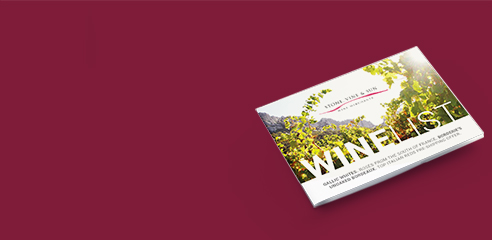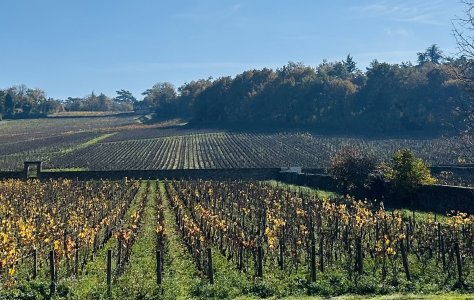Languedoc-Roussillon
There’s something very complete about our annual offer of wines from the Languedoc and Roussillon: with whites, rosés and reds, and wonderful fortified wines, the Vins Doux Naturels which are such a speciality of the region, there should be something for all tastes. Secondly, there are wines for every budget; at every level we believe these wines continue to offer terrific interest and value for money, at a time when finding such within the euro zone has become harder than ever. That’s why we continue to promote and recommend the wines of Languedoc-Roussillon with such enthusiasm. Now the region has really got its act together too, coming up with a unified marketing strategy under the jolly banner of “Sud de France”, and the creation of a new all-embracing Languedoc appellation, which stretches across the whole arc from east of Montpellier down to Perpignan.This replaces the Coteaux du Languedoc: a carefully delimited area of vineyards widely spread from near Nîmes in the northeast to La Clape near Narbonne in the south-west.
There are two sub regions (Pic Saint-Loup and La Clape) which are allowed to put their names alone on the label. These two are presumably to be up-graded to full appellations in their own right at some point. Secondly various terroirs(e.g. Terrasses de Larzac, Grés de Montpellier), will continue; and the names of several better villages (e.g. St. Georges d’Orques, Montpeyroux) will continue to appear on labels as well. Is that straightforward?
We occasionally refer to wines from this region showing the influence of the Garrigue, a word which has no exact translation in English. It describes that evergreen scrub which covers untilled land around the vineyards in many areas of the Languedoc, especially around Montpellier. The vegetation, usually dominated by the diminutive Kermes oak and arbutus (the strawberry tree), is intensely aromatic in the heat of summer with bushes of bay, thyme, rosemary and lavender all contributing to a heady scent of herbs. The transmission of these aromatic oils to the skin of the grapes and hence to the wine is ill-defined, but elusive traces of those herbal flavours appear in some wines, as they do in certain wines of the southern Rhône as well.
Vin de Pays
Vin de Pays takes up 1/3 of the vineyard area; and makes up just over half of all French Vin de Pays, and 88% of all French Vin de Pays labelled varietally. The resultant sea of wine totals 4.5m hl, and just to put that in contcxt, it’s over three times as much wine as produced by the whole of New Zealand! Most Vin de Pays comes from the plain around Narbonne and Béziers. Once reserved for wheat growing (whilst vines were limited to the poorer land on the hills) this area saw wholesale conversion to vineyards in the nineteenth century. But flat land is not all bad: it permits mechanisation; and, once small-holdings have been consolidated into larger units - by co-operatives or dynamic family estates - it’s good for the production of large volumes of very drinkable wine at modest cost.
The volume makes it important, and when something becomes important in France it means that bureaucrats love fiddling with it. Most of our vignerons, who make wine from their own, family-owned vineyards (i.e. not blended from widely disparate regions) could label their Vin de Pays in three different ways: either simply Vin de Pays d’Oc; or Vin de Pays of their respective departement, e.g. Aude, Garde etc.; or under the name of over 50 local districts, most of forgettable banality, but some of poetic value (sadly I have not yet tasted wine from the promising Vallée du Paradis!).
We offer Vin de Pays in a number of guises and from a variety of sources: first, there are unpretentious wines, either blended or varietally labelled wines, such as those from the Vic family, or sourced by negociant Alain Grignon; secondly, there are Vin de Pays from estates specialising in their production, devoting as much care and attention to their wines as any appellation wine - those from Croix Belle come into this category; thirdly there are Vin de Pays made by excellent producers alongside their appellation wines, usually from old vineyards of varieties not permitted by the local appellation rules.
Coteaux du Languedoc - Pic Saint-Loup
The 1400 hectares of vineyards of Pic Saint-Loup (named after a hermit who lived on the mountain), lie just to the north of Montpellier, around the remarkable jagged rock which juts like a shark’s fin into the blue southern sky, and the secondary pile of L'Hortus just to the north. The Pic enjoys a fresher micro-climate than most of the Languedoc, with a little more rainfall and cooling breezes from the north. Syrah is particularly successful here, loving the combination of moderate temperatures and limestone-based soils.
The reputation of Pic for quality has been boosted by the determination of the local growers, many of whom are newcomers, to improve standards. Some years ago they put in place their own stricter rules: 90% noble grapes - i.e. Syrah, Grenache and Mourvèdre; maximum yields of 50hl./ha.; and no wine from vines less than 6 years old. Full appellation status beckons
Coteaux du Languedoc - Terrasses du Larzac
This zone covers a wide range of terroirs in the north of the Coteaux du Languedoc, abutting the Larzac plateau. We increasingly feel that this area is one of the most impressive in the whole of the Languedoc, especially in the hilly band up against the Larzac plateau, which runs from St Jean de la Blaquière in the west, across via St. Saturnin and Montpeyroux to Puéchabon in the east.
Our grower: Geraldine Combes and Xavier Peynaud at Mas des Brousses
Coteaux du Languedoc - Picpoul de Pinet
Picpoul de Pinet is a little known appellation near the Bassin de Thau, east of Béziers. Comprising vineyards near the sea on sandy soil and gravels further inland, it is an unusual appellation in that it exists just for a single grape, the white Piquepoul. The grape has the advantage of being slow-ripening: picked after the heat of summer has passed it retains freshness and flavour. The wine is much appreciated within France: a staple in Parisian bistros to accompany seafood. Fresh, slightly sharp with a bit of weight and a tang of the sea about it, it really does wash down oysters, mussels or fish perfectly (the vineyards are within sight of the oyster beds in the Bassin). Look on it as the Muscadet of the Mediterranean, albeit with a little more heft and alcohol.
Our grower: Julie Benau at Domaine de Creyssels
Coteaux du Languedoc - La Clape
Driving through the wild, limestone garrigue of La Clape, one wonders why anyone ever took such pains to make wine here. Vineyards have been painstakingly created in patches amidst the limestone outcrops, and the land laboriously cleared of scrub and stones. It’s a fascinating spot: once a rocky island cut off from the mainland, its potential for viticulture was actually spotted by the Romans, who planted vines and shipped wine from here back to their distant capital. Wines from this micro-terroir continue to have an excellent reputation, leading to La Clape (with Pic St. Loup) being allowed to stand alone on labels, although it is not yet an appellation.
The combination of a little altitude (the rock rises over 200m) sea mists, and plentiful wind gives freshness to the air here, and extends the growing season. The sole challenge to growers is a continuing, serious drought, with less than 200mm of rain a year: as a result a special derogation to permit drip irrigation has been requested and granted.
White La Clape merits special notice, with Bourbolenc being particularly successful. Whites may be comparable in quality and style to white Châteauneuf-du-Pape.
Our grower: Château Karantes
Faugères
Faugères is a small appellation - only 2,000 hectares in production, with some 150 growers and 40 odd producers. In the north of the appellation, the hills rise up to about 350m, offering breezes and fresher temperatures: here Syrah thrives. Some of the growers here look on Faugères as the top appellation of the whole of the Languedoc, but then they would, wouldn't they...
Its interest, and consistent quality, lies in its unusul geological homogeneity, unique in Languedoc-Roussillon: all of the vineyards lie on schist. We repeatedly refer to schist in this offer: we believe it’s important as we consider wine from vines grown on schist, which is acidic, can display a distinctive, high-toned scent and flavour. Schist is a rock, found in a band across Faugères and the north of St. Chinian, but also in Corbières and Roussillon, notably around Maury and in Collioure. It’s a metamorphic rock formed of foliated sedimentary layers changed by heat and pressure. Its common distinguishing feature, like slate, is that it splits easily into thin flakes or slabs, so the vineyards look as though they are covered in shards of rock; which can range in colour from soft pinky-beige in Faugères to coal-black near Maury in Roussillon. It is hard to see how vines can survive on such a sterile matrix: they do so through their roots penetrating deep into the fissures in the rock to find moisture and nutrients during the long dry summers.
Our grower: Domaine du Météore
St. Chinian
St. Chinian, named after a ninth century monk who became St. Aniane, lies in the hills 30km north-west of Béziers. Its status as one of the most exciting districts in the whole of the south was recognised as early as 1982 when St. Chinian earned AOC status as a Cru within the Coteaux du Languedoc. Now the authorities are sub-dividing it further, identifying two zones, one to the north-west around Berloup for wines based on Syrah, and the other to the north-east around Roquebrun for wines based on Carignan.
Our grower: From the schistous hills in the north at Roquebrun we ship from impish Thierry Navarre.
Minervois
Minervois, granted appellation status in 1985, is a large appellation of some 5000 hectares of vineyards across a dry landscape: La Livinière is one of the driest spots in the whole of France.
Repeated visits, even to estates in the leading sub-region of Minervois La Livinière, have convinced us that is one of the least interesting areas in the south, for two reasons. First the land is, largely, boring - plains and gentle hills, lacking the excitement of the rock terroirs which surround it. Secondly Syrah has become the predominant red grape variety, supported by Grenache and Mourvèdre; but Syrah-dominated wines have lost some of the local character which makes the Languedoc so interesting, particularly if dressed up with too much oak and a heavy bottle!
Ouir grower: Château La Grave, owned by the Orosquette family, who produce honest, easy-drinking, approachable wines at reasonable prices, rather than trying to over-achieve from their land.
Corbières
The appellation of Corbières, established in 1985, is by far the largest in the Languedoc, and indeed the fourth largest in all of France, with over 15,000 hectares under cultivation. This is largely supermarket wine territory, dominated by a couple of huge but decent co-ops.
Since 1991 there have been efforts to sub-divide this largely mountainous region into 11 different terroirs, several of which have limited validity.
Our grower: we always offer a wide range of wines from Bruno Schenk at Domaine du Grand Arc, in the southernmost region, Quéribus.
Roussillon: Côtes de Roussillon and the Agly Valley
The vineyards in the north and west of the Roussillon - away from the plain around Perpignan - are spectacular, especially along the wide and steep valley of the Agly river, near St. Paul de Fenouillet and Maury, and the parallel valleys, for example around Tautavel or Latour-de-France. Here gnarled old vines scratch out an existence on schist, decayed granite or gneiss, in a brutally hot, dry and windswept environment. This may be the ultimate Stone, Vine & Sun terroir!
Our grower: Pierre Fontaneil at Domaine Fontanel in Tautavel, who makes superb red, white and fortified wines
Collioure
It’s a fascinating feeling to drive through Perpignan and see the orange and yellow flag of the Catalans widely displayed. This is a region which lies twixt France and Spain, home to an unintelligible local dialect and highly independent citizens.
The appellation of Collioure lies at the eastern extremity of the Pyrenees, mountains which abut the Mediterranean. The vineyards may be either right alongside the sea or on precipitious terraced slopes just inland, cut by numerous diagonal drainage channels, known as les Peus de Gall in Catalan, the chicken’s feet which they resemble. Soils are largely schistous. Alongside the still wine appellation, and with the same boundary, is the vin doux naturel appellation of Banyuls, named after the old fishing port a few kilometres to the south of Collioure. Low yields and the harsh setting for the vineyards mean that wines from Collioure are never going to be cheap: but certainly comparable in quality to, say, Châteauneuf-du-Pape.
Roussillon - Vin Doux Naturel
A speciality of Roussillon is the production of Vins Doux Naturels. These are made by stopping the fermentation of very ripe grapes, part way through its course, by the addition of alcohol (a process known as mutage); thereby preventing the yeasts from working, and leaving a fortified wine with plentiful natural grape sugar and anywhere between 15 and 17 degrees of alcohol.
This is an ancient tradition. Whereas the roots of the distillation of alcohol may be unclear - perhaps Spain or Italy - the particular use of alcohol to halt fermentation, and thus retain sweetness, was documented in the late thirteenth century by the Catalan chemist Arnaud de Villeneuve of Montpellier University, under the patronage of the King of Majorca, then ruler of Roussillon.
As one can see below, Vins Doux Naturels come in different colours and styles; and from diverse regions. Rivesaltes VDNs are named after the town near Perpignan, but can be made over a relatively large area, either eponymously from Muscat or a wide range of other white grapes such as Grenache Blanc and Malvoisie. Maury is more narrowly circumscribed, with red fortified wines from Grenache Noir coming from the schistous (often almost coal-black) vineyards around the town in the Agly Valley. Banyuls shares the same vineyard area as Coll: if fortified the appellation wines are called Banyuls, if still, then Collioure.
Note that Maury and Banyuls are almost the only wines which accompany chocolate puddings, rather as berried fruit may be dipped in chocolate. As a more fruity and less tannic variant of port, however, they are equally at home with cheese, and all are perfect for late night, meditative sipping. The level of alcohol means they keep well too, so you don’t have to drink a whole bottle at one sitting!
These wines are not well-known here, but whenever we close a tutored tasting of Languedoc-Roussillon wines with a Vin Doux Naturel, it always steals the show and sales follow. Be open minded and experiment.
Examples from: Domaine Fontanel



